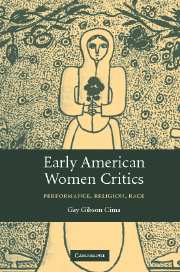Book contents
- Frontmatter
- Contents
- Acknowledgments
- Introduction
- 1 Colonial Women Critics: Performing Religion, Race, Possession, and Pornography
- 2 Revolutionary Women Critics: Performing Rational Christianity, Patriotism, and Race
- 3 Republican Women Critics: Performing Christian Activism, American Culture, and Race
- Index
- References
1 - Colonial Women Critics: Performing Religion, Race, Possession, and Pornography
Published online by Cambridge University Press: 22 September 2009
- Frontmatter
- Contents
- Acknowledgments
- Introduction
- 1 Colonial Women Critics: Performing Religion, Race, Possession, and Pornography
- 2 Revolutionary Women Critics: Performing Rational Christianity, Patriotism, and Race
- 3 Republican Women Critics: Performing Christian Activism, American Culture, and Race
- Index
- References
Summary
[The Reverend] has scared half the People, especially Women and Children, almost out of their Wits … he has made an amazing Alteration, and all Faces gather Blackness … after his last Sermon there was an amazing universal Groan.
Postscript, The South-Carolina Gazette, 18 June 1741: 2, my italicsThe Wheels of a heated Imagination set thus a going, God only knows where they will stop, whether in Bedlam, or Rome, or no Christianity, or no Religion at all.
Anglican Commissary Alexander Garden, “Take Heed How Ye Hear,” 1740 sermonThe First Great Awakening began with a crisis of belief. As colonists fell away from Puritan churches, they lost confidence in civic institutions in general. They no longer perceived church boards or town councils as representative, so they began to question their Old Light ministers and lay leaders. Since laymen in “established” or state-supported churches held high political offices as well, this religious questioning held political ramifications. The New Light ministers of the Great Awakening, rebelling against the governing Old Light Congregationalists, Presbyterians, and Anglicans, started preaching Biblical narratives of liberation in addition to old Puritan stories of obedience and damnation. New Lights also re-imagined the nature of identity. Old Lights had argued that identity was visibly marked on one's body and that wealth was a mark of God's grace. They had valued book learning and confirmation on English soil. New Lights replaced this ideology. They viewed identity as invisible, as an inner grace and simplicity.
- Type
- Chapter
- Information
- Early American Women CriticsPerformance, Religion, Race, pp. 18 - 69Publisher: Cambridge University PressPrint publication year: 2006



